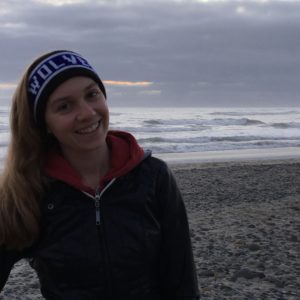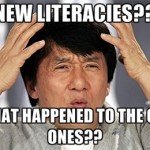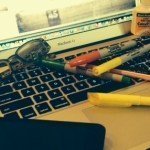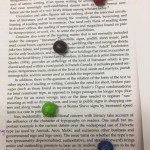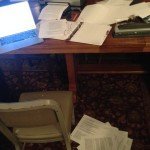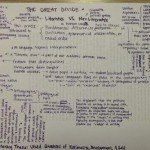
Featured Curators: Zeth Martinez & Shannon Miller
My Absolute Objective and Correct Opinion Based on Little Evidence and Biased Analysis
By Zeth M. Martinez
I was assigned to blog for February 25, 2019, but without collecting more data it has been hard to definitively define “literacy” so as to publish and profit from my findings. An assessment of the date above may prove invaluable for further research. In the class prior, we chose groups and decided on an essay in common as well as our own individual reading. I chose the Part III Time-Focused Approaches as I had already read the entirety of Part II and III when I had thought “part” and “chapter” were interchangeable terms. They were not. There was a small hope that this would at least reduce the cost of labor (time). However, after a quick read, I came to the horrible realization I would need to read the entirety of both essays again. This did not reduce the cost of labor. When class started we met with our groups.
Our group discussed our reading in common, Chapter 12 “Historical Inquiry in Literacy Education Calling on Clio” by Bill Green. Isaiah, a member of my group, lead the discussion by asking our thoughts of the essay in question. The consensus of the Tribunal of Part III—Shane, Isaiah, and myself—was that the essay made interesting points and the overall thesis was valid but we all had our own unique concerns. My concern was that the essay seemed to challenge other literacy studies such as New Literacy Study (NLS) without convincing me that there was any true attack on historical inquiry. As stated in the text, “literacy as a situated socio-cultural practice” (185) had become the dominant form through literacy studies such as NLS. However, there wasn’t enough done for me to believe there was any true friction between this field of thought and a study of historical dimensions. For Shane, the criticism mostly came from the structure of the essay itself. His blog expressed his major concern most directly, “(the essay) is marred, I feel, by a lack of clear examples conducive to the declared aims.” After discussion, we came to the conclusion that the evidence was buried within the essay making it harder to contribute to the line of thought it was meant to support. For Isaiah, it was a matter of the essay not saying much at all. However, I will say his secondary essay was the best of Part III so his overall opinion may have been overshadowed by that lens. It was the essay I wanted for myself but he called it first which makes him an objectively bad person. I have no proof to support my claims but I feel it to be true so true it must be. What was convincing about the essay was that history was an underutilized aspect of literacy study that could provide a context in the open concept of literacy itself. After this discussion, we selected a quote for a shared google doc and chatted about concepts that could never evoke conflict—life, politics, how amazing and humble I am—until we moved to the next stage of class.
The wonderful, amazing, and person-in-charge-of-my-grades, Dr. Jaxon—who is wonderful and amazing—suggested that our group go first to follow chronological order. So I—and possibly Isaiah—glared at Shane until he felt obligated to speak. It was a successful strategy. Shane was “eager” to take up this mantle and I was perfectly fine with him doing all the talking so long as I reaped a majority of the rewards. Shane brought into class discussion Bill Green’s concept of history as reminiscent to String Theory, which brought about a plethora of conversation and absolute fear to me as it wasn’t previously approved by the Tribunal of Part III. The class wanted to understand the concept of time travel and string theory we were suggesting. Naturally, I thought of a way to shift all blame and focus on Shane or possible Isaiah until Charlotte mentioned The Flash which suddenly made the concept click for myself. This would allow me the tool to take all the credit when the opportunity presented itself. Hannah E. said she does not watch The Flash so the quest for another possible substitute began. Isaiah brought up Jet Lee’s The One as an example of history merging within itself and creating something new. I liked this suggestion and its implication however few knew the reference and it was an example of finite possibilities. This was added with Looper—brought up by Neesa—as a contender for The Flash replacement. However, both Looper and The One were examples of finite time travel with direct and linear cause and effect. The Flash, or a multibranched multiverse, was a more accurate description so the conversation turned to Rick and Morty. An infinite plethora of historical cause and effect meant to be studied to gain a perspective of literacy was better fitted into the context of Rick and Morty’s multiple dimensions where a single change altered the worlds in notable ways.
Hannah E., or non-The Flash watcher, grounded the conversation back to literacy with a question summed to the best of my ability as, “But what does this have to do with literacy?” The question caught us off guard but ever since Charlotte brought up The Flash I felt confident in how to ground the conversation back to literacy.
In short, I hatched my plan to take credit for Shane and Isaiah’s hard work by throwing my two cents at everyone. My response was best summed up as, “history is a dimension of literacy underutilized. The developing relationship to literacy as a practice and concept has a historical progression that can better ground our understanding of the study of literacy.” Of course, this was said in my signature—and trademarked—mumble, repetition, and bumbling but the point seemed to satisfy self-proclaimed non-The-Flash watcher Hannah E.
All groups had a chance to engage their readings and all did so in unique ways. For example, the group in charge of Part IV Multimodal Approaches assigned each group a word with a task to create three different modes of engaging these words to express transmediation and transduction. All in all, it was fun to see how everyone engaged their readings. In fact, it was too much fun. As I’m sure all are aware, the acceptable amount of enjoyment from any classroom experience is anywhere between 5 to 5.8 out of 10 (according to my current fancy at the moment). Anything below 5 leaves the student to wander in thought and anything above 5.8 distracts them from absorbing the allotted material of the day. This was beyond the 5.8 and must be treated as an outlier.
(No participants were harmed in the collection of this data. One suffered discomfort after making direct eye contact with me but that was all.)
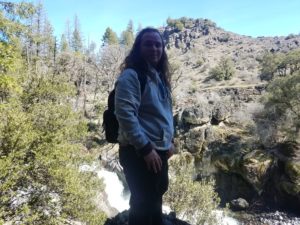 Author Bio: Zeth M. Martinez is a graduate student seeking his Masters in Creative Writing at CSU, Chico, and is certainly human. He has been published in the 9th volume of Multicultural Echoes and was on the editorial board of Watershed Review. Both would agree he’s a real-life human being with recently upgraded prehensile grip. He has only recently realized most of his stories revolve around death, which may speak lowly of his self-analysis and reflection units. A fellow human has described him as “an emotionless robot.” Zeth simply replied, “[Insert Response 13-B].” It was an acceptable response given default factory settings.
Author Bio: Zeth M. Martinez is a graduate student seeking his Masters in Creative Writing at CSU, Chico, and is certainly human. He has been published in the 9th volume of Multicultural Echoes and was on the editorial board of Watershed Review. Both would agree he’s a real-life human being with recently upgraded prehensile grip. He has only recently realized most of his stories revolve around death, which may speak lowly of his self-analysis and reflection units. A fellow human has described him as “an emotionless robot.” Zeth simply replied, “[Insert Response 13-B].” It was an acceptable response given default factory settings.
From Shannon Miller:
Every Monday night is a thought provoking experience in our Theories of Literacies classroom. This week’s session was by far one of the most intriguing, mostly due to the fact that we were able to choose our sections from the Routledge Handbook of Literacy Studies that we wanted to read. The available options were:
Section II: Space-focused approaches
Section III: Time-focused approaches
Section IV: Multimodal approaches
Section V: Digital approaches
Section VI: Hermeneutic approaches (of which our classroom consensus resulted in a resounding “Nope”)
Section VII: Making Meaning from the Everyday
and lastly,
Section VIII: Communities.
My group and I chose Digital approaches because we are fascinated by all this new-fangled technology and how it relates to learning. The subsection that I chose to read, “Consumer Literacies and Virtual World Games,” was right up my alley. The whole chapter talked about younger kids (ages 8 to 11) and what virtual world games they play on a regular basis. This hits home because growing up, a large chunk of my time, daily, was taken up playing stuff like Neopets and Runescape. More specifically, this chapter focuses on the fiscal relationship that kids have with these types of games. Generally, wealthier kids spend more time playing one or two virtual world games on a regular basis and have their parents pay for monthly memberships, which allows them to have access to exclusive items. Other kids who may or may not have their own home computer tend to play these types of games too, however, they are not as likely to have a membership and they also tend to play many games sporadically as opposed to focusing on just one. Children from lower income families play a multitude of games almost exclusively at school, usually the only place where they have access to a computer.
It then goes on to talk about the ways in which these games get kids and their parents to spend money on them. My favorite quote, probably from this whole book even, is when the researchers: “analyzed what they termed ‘Neopian economics of play’ on the Neopets website, highlighting the capitalist ideology present through the various activities on the site, as well as through product placement, sponsorship, cross-media promotion, and branding” (383). It’s just so hilarious to me because, as a kid, I was totally obsessed with everything Neopets. Of course, back in my day, the advertising wasn’t as blatantly obvious as it is today. All these young whippersnappers and their “pay to play” games, tisk tisk… Unfortunately, people (and especially kids) play into all the tactics used to take money.
Anyway, each group had the opportunity to share what their section was about with the class. They all had some pretty interesting aspects to them, such as the group who had “Time” as a section. The way they described the perception of time was that each and every little event (in this case, concerning literacy) could have happened differently each and every time, spawning an unlimited number of possible time lines. Someone even compared it to string theory, which I know next to nothing about, so I’ll just take their word for it. Another group had us do an activity which definitely helped liven the class up. Each group was given a sheet of paper with a word on it and we all had to present that word in at least three different modalities, be it speaking, drawing, acting it out, writing, etc. My group’s word was “dance” so naturally we used a gif of Tina Belcher for one portrayal, while the others included actually dancing, drawing someone dancing, and actually writing the word.
My own group gave a brief summary of how the digital platforms are becoming more prominent in society as a whole and how so many students are using it out of the classroom and inadvertently learning from it. In countries like China, for example, while students enroll in English classes, so much pop culture is from the United States that even out of the classroom, they are immersing themselves in English language content. Unfortunately, we are still in the early ages of digital technologies and with all that is changing, we still cannot fully grasp the pedagogical implications these resources might have on students.
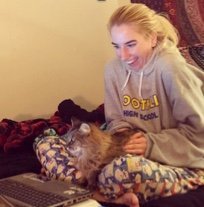 Author Bio: Shannon Miller is a Masters student at Chico State who likes cats and laying in bed. Originally from the Bay Area, she hopes to go on to teach English to students far and wide.
Author Bio: Shannon Miller is a Masters student at Chico State who likes cats and laying in bed. Originally from the Bay Area, she hopes to go on to teach English to students far and wide.


